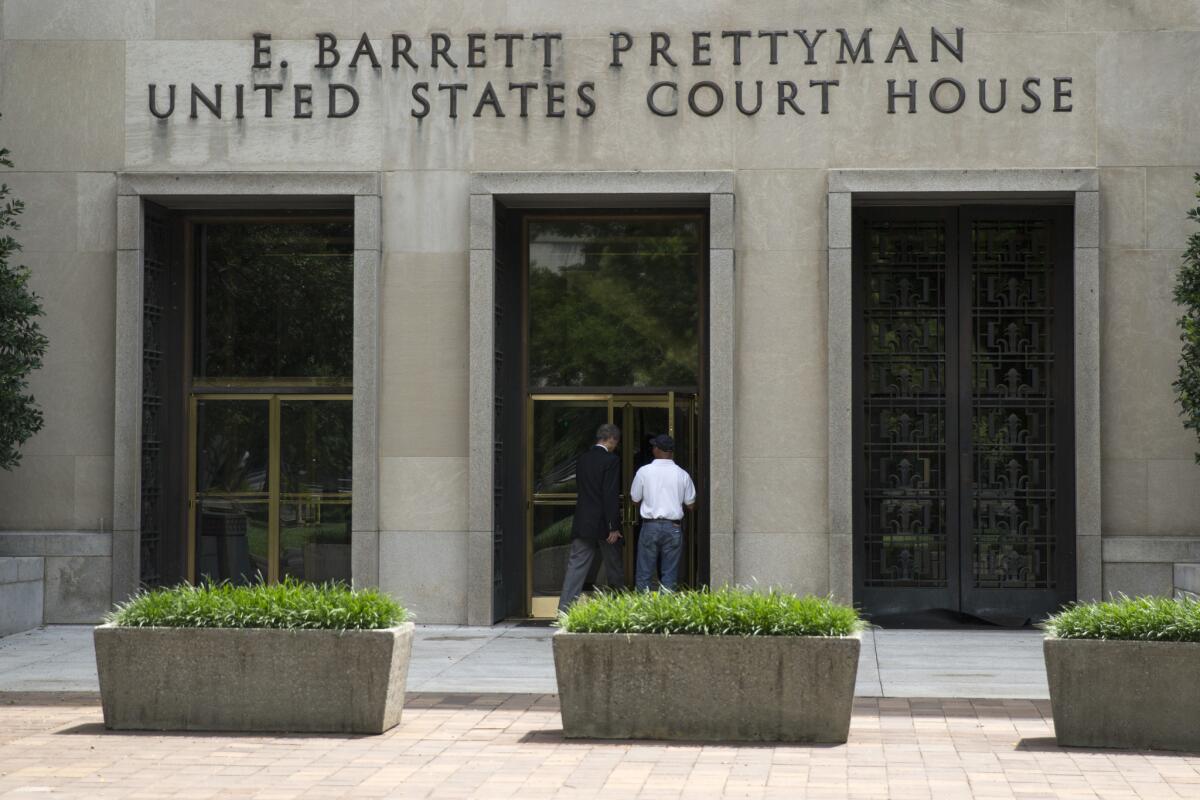Opinion: Obamacare subsidies lead two courts to battle over law’s meaning

Well, that certainly clears things up.
Hours after a federal appeals court ruled Tuesday that the 2010 healthcare law provided insurance subsidies only to people living in 14 states, another appeals panel reached exactly the opposite conclusion in a separate lawsuit.
At issue is the provision in the law that determines how large the subsidies will be, not who’s eligible for them. Nevertheless, opponents of the law have seized on the language, which bases a family’s subsidy in part on the price it paid for a policy bought “through an exchange established by the state.” That language, they argue, flatly prohibits subsidies for anyone who shops at one of the 36 (soon to be 34) exchanges operated by the federal government.
The IRS issued regulations that nevertheless allowed people in all 50 states to seek subsidies, which take the form of a tax credit for premiums. The regulations drew four lawsuits across the country, two of which generated appellate rulings Tuesday.
The split between the circuit courts boiled down to whether the provision in question represented a true expression of Congress’ intent or just sloppy legislating. One might think that the much-maligned process of enacting Obamacare would weigh heavily in favor of the latter position, but two judges on the D.C. Circuit were not inclined to amble down memory lane. And though they acknowledged that barring subsidies in the federally run exchanges would wreak havoc on the insurance markets there, as well as harming many people who now depend on subsidies to make their policies affordable, they contended that the language of the provision was so clear, it’s beyond the power of the IRS or the courts to change it.
So clear, in fact, that four other judges drew an entirely different conclusion about the meaning. Three -- including the dissenting judge in the D.C. Circuit -- said the provision clashed so sharply with other provisions of the law, its meaning was completely ambiguous. In such circumstances, they wrote, it was entirely appropriate for the IRS to apply an interpretation that was consistent with the overall goals of the act. The fourth judge said that the provision was not confusing when read in context, and did not bar subsidies in the exchanges run by the federal government.
It’s worth remembering that state legislatures didn’t discuss the possibility of denying subsidies to their residents when they debated whether to set up an exchange. And no small number of their constituents are affected by this issue -- according to a recent study, 7.3 million Americans could be receiving subsidized insurance by 2016, including 2 million in Texas and Florida alone.
They didn’t consider that possibility because no one interpreted the law that way; like members of Congress, state lawmakers knew that the Affordable Care Act intended subsidies to be available nationwide. The D.C. Circuit’s ruling noted that a Senate committee proposed to temporarily withhold subsidies to give states more incentive to run their own exchanges, but that bad idea never made it out of committee. The incentive chosen instead was more consistent with the Democrats’ modus operandi: They provided huge grants to defray the cost of setting up and marketing an exchange.
Which brings us back to sloppy legislating. Any bill as big as the ACA is bound to have inconsistencies, typographical errors and oversights. In the ACA’s case, senators assumed that they’d be able to give the bill a final vetting when they negotiated a compromise version with the House. But when Republican Scott Brown’s victory in a special election in Massachusetts ended the Democrats’ filibuster-proof coalition, they had to abandon the plan for a conference. Instead, the House approved the Senate bill, warts and all. Democrats used the reconciliation process to jam through a second measure that rewrote parts of the Senate bill, but that measure couldn’t address every part of the Senate bill. Besides, some of the ACA’s shortcomings were not immediately apparent.
The two judges on the D.C. Circuit seemed to take a “You break it, you bought it” approach to legislative draftsmanship, holding that a single provision of the law could contradict other ones and undermine Congress’ intent. The four other judges that weighed in Tuesday disagreed, saying that when one provision of a law seems to conflict with others, an administrative agency had the latitude to impose consistency.
Some might argue that the D.C. Circuit was just trying to hold the line against an imperial presidency. In this case, though, the administration was just trying to do what Congress wanted it to do, despite the mangled marching orders from Capitol Hill. That’s different from the administration’s actions on, say, No Child Left Behind and immigration, where it has forged ahead in new directions as Congress remains stuck in neutral.
(Interesting side note: One of the plaintiffs was a West Virginian who told the court he objected to government handouts. He claimed to be injured by the law because the availability of subsidies in his state meant that he wouldn’t qualify for the financial hardship exemption from having to buy insurance. With the federal subsidies, the D.C. Circuit said, the man’s policy would cost less than $2 a month. According to eHealthInsurance, the average premium for an individual policy in his state was a little more than $300 a month.)
Follow Healey’s intermittent Twitter feed: @jcahealey
More to Read
Sign up for Essential California
The most important California stories and recommendations in your inbox every morning.
You may occasionally receive promotional content from the Los Angeles Times.











